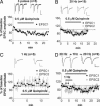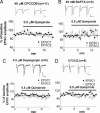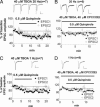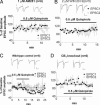Frequency-specific and D2 receptor-mediated inhibition of glutamate release by retrograde endocannabinoid signaling
- PMID: 16698932
- PMCID: PMC1472459
- DOI: 10.1073/pnas.0510797103
Frequency-specific and D2 receptor-mediated inhibition of glutamate release by retrograde endocannabinoid signaling
Abstract
The mechanisms underlying modulation of corticostriatal synaptic transmission by D2-like receptors (D2Rs) have been controversial. A recent study suggested that D2Rs inhibit glutamate release at this synapse, but only during high-frequency synaptic activation. Because the release of postsynaptic endocannabinoids (eCBs), which act as retrograde messengers to inhibit presynaptic glutamate release, can be triggered by D2R activation and intense synaptic activation, such a mechanism could mediate dopaminergic modulation of corticostriatal transmission. Here, we show that D2R activation reduces excitatory transmission onto striatal medium spiny neurons at a stimulation frequency of 20 Hz but not at 1 Hz. This form of inhibition requires CB1 receptor activation, as evidenced by the fact that it is blocked by AM251 [N-(piperidin-1-yl)-1-(2,4-dichlorophenyl)-5-(4-chlorophenyl)-4-methyl-1H-pyrazole-3-carboxamide], a CB1 antagonist, and is absent in CB1 knockout mice. It is also blocked by postsynaptic intracellular calcium chelation, by group I metabotropic glutamate receptor antagonism, and by inhibition of postsynaptic phospholipase C. These results demonstrate a previously unrecognized role for retrograde eCB signaling in reversible and frequency-specific inhibition of glutamate release by the activation of striatal D2Rs.
Conflict of interest statement
Conflict of interest statement: No conflicts declared.
Figures







Similar articles
-
Retroinhibition of presynaptic Ca2+ currents by endocannabinoids released via postsynaptic mGluR activation at a calyx synapse.J Neurosci. 2004 Jun 30;24(26):5955-65. doi: 10.1523/JNEUROSCI.0768-04.2004. J Neurosci. 2004. PMID: 15229243 Free PMC article.
-
Retrograde endocannabinoid signaling at striatal synapses requires a regulated postsynaptic release step.Proc Natl Acad Sci U S A. 2007 Dec 18;104(51):20564-9. doi: 10.1073/pnas.0706873104. Epub 2007 Dec 11. Proc Natl Acad Sci U S A. 2007. PMID: 18077376 Free PMC article.
-
The wake-promoting peptide orexin-B inhibits glutamatergic transmission to dorsal raphe nucleus serotonin neurons through retrograde endocannabinoid signaling.J Neurosci. 2005 Jan 26;25(4):896-905. doi: 10.1523/JNEUROSCI.3258-04.2005. J Neurosci. 2005. PMID: 15673670 Free PMC article.
-
Endocannabinoid signaling and synaptic plasticity in the brain.Crit Rev Neurobiol. 2006;18(1-2):113-24. doi: 10.1615/critrevneurobiol.v18.i1-2.120. Crit Rev Neurobiol. 2006. PMID: 17725514 Review.
-
Endocannabinoid-mediated synaptic plasticity in the CNS.Annu Rev Neurosci. 2006;29:37-76. doi: 10.1146/annurev.neuro.29.051605.112834. Annu Rev Neurosci. 2006. PMID: 16776579 Review.
Cited by
-
Chronic inflammatory pain decreases the glutamate vesicles in presynaptic terminals of the nucleus accumbens.Mol Pain. 2018 Jan-Dec;14:1744806918781259. doi: 10.1177/1744806918781259. Epub 2018 May 17. Mol Pain. 2018. PMID: 29770746 Free PMC article.
-
Cyclic AMP and afferent activity govern bidirectional synaptic plasticity in striatopallidal neurons.J Neurosci. 2014 May 7;34(19):6692-9. doi: 10.1523/JNEUROSCI.3906-13.2014. J Neurosci. 2014. PMID: 24806695 Free PMC article.
-
Endogenous dopamine and endocannabinoid signaling mediate cocaine-induced reversal of AMPAR synaptic potentiation in the nucleus accumbens shell.Neuropharmacology. 2018 Mar 15;131:154-165. doi: 10.1016/j.neuropharm.2017.12.011. Epub 2017 Dec 7. Neuropharmacology. 2018. PMID: 29225042 Free PMC article.
-
Dopamine-dependent corticostriatal synaptic filtering regulates sensorimotor behavior.Neuroscience. 2015 Apr 2;290:594-607. doi: 10.1016/j.neuroscience.2015.01.022. Epub 2015 Jan 28. Neuroscience. 2015. PMID: 25637802 Free PMC article.
-
Regulator of calmodulin signaling knockout mice display anxiety-like behavior and motivational deficits.Eur J Neurosci. 2012 Jan;35(2):300-8. doi: 10.1111/j.1460-9568.2011.07956.x. Eur J Neurosci. 2012. PMID: 22250817 Free PMC article.
References
Publication types
MeSH terms
Substances
Grants and funding
LinkOut - more resources
Full Text Sources
Other Literature Sources

